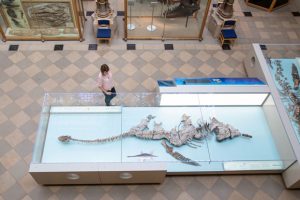Elasmosaurus Model (Safari Ltd) Under the Spotlight
New to the Wild Safari Dinosaurs and Prehistoric Life model series manufactured by Safari Ltd for 2013, is this replica of Elasmosaurus, a member of the plesiosaur group, one of the last types to evolve and a marine reptile with approximately half of its entire body length made up by its extraordinarily long neck.
Elasmosaurus was named and described by the American palaeontologist Edward Drinker Cope from fossils discovered in Wyoming. He had a preconceived idea that this sort of creature would be propelled through the water by its tail. This in part, explains why when it came to reconstructing the holotype material, Cope ended up putting the head on the tail, a mistake that was pointed out to him much to his subsequent embarrassment. The design team at Safari Ltd have avoided such errors and this model is a very accurate representation of an elasmosaurid.
Elasmosaurus Model
Wild Safari Dinos & Prehistoric Life Model Series Elasmosaurus
Picture credit: Everything Dinosaur/Safari Ltd
Focusing on the neck, this model is posed with the neck slightly curved, but a swan-like posture has been avoided. The neck is held out almost horizontally from the body and this reflects the current scientific thinking regarding these Late Cretaceous plesiosaurs. The small head on the end of that enormous neck could permit Elasmosaurus to approach shoals of fish in order to hunt, without the fish being too alarmed.
There are some wonderful details on the head. Firstly, the teeth are thin and give the impression of being needle-like. The teeth in the upper jaw of this model project forward in a very pronounced way, this reflects elasmosaurid teeth very accurately. Their teeth being perfectly evolved to interlock, trapping any poor unfortunate fish that should have strayed within range. The jaws themselves give an indication of being very powerful. The back of the skull is widened slightly to give the impression of the presence of strong jaw muscles. The eyes although small, are positioned above the mid-line of the skull, which again reflects what is seen in the fossil record.
The Model Reflects the Known Fossil Material Accurately
Picture credit: Everything Dinosaur
The body of the model and those four wing-like paddles give this replica a certain rigidity. It is likely that Elasmosaurus was a predator of the open ocean, ambushing prey by attacking from below using its strong flippers to provide the burst of speed necessary for an attack. Compared to the neck, the tail is relatively diminutive, but the model makers have successfully avoided making the tail too stumpy. The creases and folds in the skin at the base of the tail and also seen halfway up the tail on the other side hint at movement – which is a nice touch.
Muted Colouration
Compared to other Safari Ltd marine reptile models, the colouration is quite muted. The top of the body is painted a dark green colour, which contrasts nicely with sandy coloured underside. The detailing around the head has been enhanced by careful painting.
The skin itself has a stippled effect and feels quite rough to the touch. We are not aware of Elasmosaurus skin impressions being preserved within the fossil record. However, fossilised skin impressions from earlier Jurassic plesiosaurs suggest that the skin was relatively smooth, any scales present may have been extremely small, although on some parts of the body the skin may have been slightly wrinkled.
This Elasmosaurus model from Safari Ltd does reflect the known fossil material well and it represents an extremely good reconstruction of this Late Cretaceous marine reptile.
To view the range of prehistoric animal models available from Everything Dinosaur: Wild Safari Prehistoric World Figures.








Leave A Comment